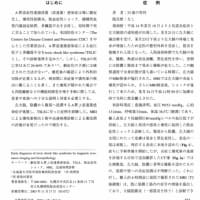Dexmedetomidine vs Midazolam or Propofol for Sedation During Prolonged Mechanical Ventilation: Two Randomized Controlled Trials
Stephan M. Jakob, Esko Ruokonen, R. Michael Grounds, Toni Sarapohja, Chris Garratt, Stuart J. Pocock, J. Raymond Bratty, Jukka Takala , for the Dexmedetomidine for Long-Term Sedation Investigators
ABSTRACT
Context Long-term sedation with midazolam or propofol in intensive care units (ICUs) has serious adverse effects. Dexmedetomidine, an α2-agonist available for ICU sedation, may reduce the duration of mechanical ventilation and enhance patient comfort.
Objective To determine the efficacy of dexmedetomidine vs midazolam or propofol (preferred usual care) in maintaining sedation; reducing duration of mechanical ventilation; and improving patients' interaction with nursing care.
Design, Setting, and Patients Two phase 3 multicenter, randomized, double-blind trials carried out from 2007 to 2010. The MIDEX trial compared midazolam with dexmedetomidine in ICUs of 44 centers in 9 European countries; the PRODEX trial compared propofol with dexmedetomidine in 31 centers in 6 European countries and 2 centers in Russia. Included were adult ICU patients receiving mechanical ventilation who needed light to moderate sedation for more than 24 hours (midazolam, n = 251, vs dexmedetomidine, n = 249; propofol, n = 247, vs dexmedetomidine, n = 251).
Interventions Sedation with dexmedetomidine, midazolam, or propofol; daily sedation stops; and spontaneous breathing trials.
Main Outcome Measures For each trial, we tested whether dexmedetomidine was noninferior to control with respect to proportion of time at target sedation level (measured by Richmond Agitation-Sedation Scale) and superior to control with respect to duration of mechanical ventilation. Secondary end points were patients' ability to communicate pain (measured using a visual analogue scale [VAS]) and length of ICU stay. Time at target sedation was analyzed in per-protocol population (midazolam, n = 233, vs dexmedetomidine, n = 227; propofol, n = 214, vs dexmedetomidine, n = 223).
Results Dexmedetomidine/midazolam ratio in time at target sedation was 1.07 (95% CI, 0.97-1.18) and dexmedetomidine/propofol, 1.00 (95% CI, 0.92-1.08). Median duration of mechanical ventilation appeared shorter with dexmedetomidine (123 hours [IQR, 67-337]) vs midazolam (164 hours [IQR, 92-380]; P = .03) but not with dexmedetomidine (97 hours [IQR, 45-257]) vs propofol (118 hours [IQR, 48-327]; P = .24). Patients' interaction (measured using VAS) was improved with dexmedetomidine (estimated score difference vs midazolam, 19.7 [95% CI, 15.2-24.2]; P < .001; and vs propofol, 11.2 [95% CI, 6.4-15.9]; P < .001). Length of ICU and hospital stay and mortality were similar. Dexmedetomidine vs midazolam patients had more hypotension (51/247 [20.6%] vs 29/250 [11.6%]; P = .007) and bradycardia (35/247 [14.2%] vs 13/250 [5.2%]; P < .001).
Conclusions Among ICU patients receiving prolonged mechanical ventilation, dexmedetomidine was not inferior to midazolam and propofol in maintaining light to moderate sedation. Dexmedetomidine reduced duration of mechanical ventilation compared with midazolam and improved patients' ability to communicate pain compared with midazolam and propofol. More adverse effects were associated with dexmedetomidine.
Stephan M. Jakob, Esko Ruokonen, R. Michael Grounds, Toni Sarapohja, Chris Garratt, Stuart J. Pocock, J. Raymond Bratty, Jukka Takala , for the Dexmedetomidine for Long-Term Sedation Investigators
ABSTRACT
Context Long-term sedation with midazolam or propofol in intensive care units (ICUs) has serious adverse effects. Dexmedetomidine, an α2-agonist available for ICU sedation, may reduce the duration of mechanical ventilation and enhance patient comfort.
Objective To determine the efficacy of dexmedetomidine vs midazolam or propofol (preferred usual care) in maintaining sedation; reducing duration of mechanical ventilation; and improving patients' interaction with nursing care.
Design, Setting, and Patients Two phase 3 multicenter, randomized, double-blind trials carried out from 2007 to 2010. The MIDEX trial compared midazolam with dexmedetomidine in ICUs of 44 centers in 9 European countries; the PRODEX trial compared propofol with dexmedetomidine in 31 centers in 6 European countries and 2 centers in Russia. Included were adult ICU patients receiving mechanical ventilation who needed light to moderate sedation for more than 24 hours (midazolam, n = 251, vs dexmedetomidine, n = 249; propofol, n = 247, vs dexmedetomidine, n = 251).
Interventions Sedation with dexmedetomidine, midazolam, or propofol; daily sedation stops; and spontaneous breathing trials.
Main Outcome Measures For each trial, we tested whether dexmedetomidine was noninferior to control with respect to proportion of time at target sedation level (measured by Richmond Agitation-Sedation Scale) and superior to control with respect to duration of mechanical ventilation. Secondary end points were patients' ability to communicate pain (measured using a visual analogue scale [VAS]) and length of ICU stay. Time at target sedation was analyzed in per-protocol population (midazolam, n = 233, vs dexmedetomidine, n = 227; propofol, n = 214, vs dexmedetomidine, n = 223).
Results Dexmedetomidine/midazolam ratio in time at target sedation was 1.07 (95% CI, 0.97-1.18) and dexmedetomidine/propofol, 1.00 (95% CI, 0.92-1.08). Median duration of mechanical ventilation appeared shorter with dexmedetomidine (123 hours [IQR, 67-337]) vs midazolam (164 hours [IQR, 92-380]; P = .03) but not with dexmedetomidine (97 hours [IQR, 45-257]) vs propofol (118 hours [IQR, 48-327]; P = .24). Patients' interaction (measured using VAS) was improved with dexmedetomidine (estimated score difference vs midazolam, 19.7 [95% CI, 15.2-24.2]; P < .001; and vs propofol, 11.2 [95% CI, 6.4-15.9]; P < .001). Length of ICU and hospital stay and mortality were similar. Dexmedetomidine vs midazolam patients had more hypotension (51/247 [20.6%] vs 29/250 [11.6%]; P = .007) and bradycardia (35/247 [14.2%] vs 13/250 [5.2%]; P < .001).
Conclusions Among ICU patients receiving prolonged mechanical ventilation, dexmedetomidine was not inferior to midazolam and propofol in maintaining light to moderate sedation. Dexmedetomidine reduced duration of mechanical ventilation compared with midazolam and improved patients' ability to communicate pain compared with midazolam and propofol. More adverse effects were associated with dexmedetomidine.



























